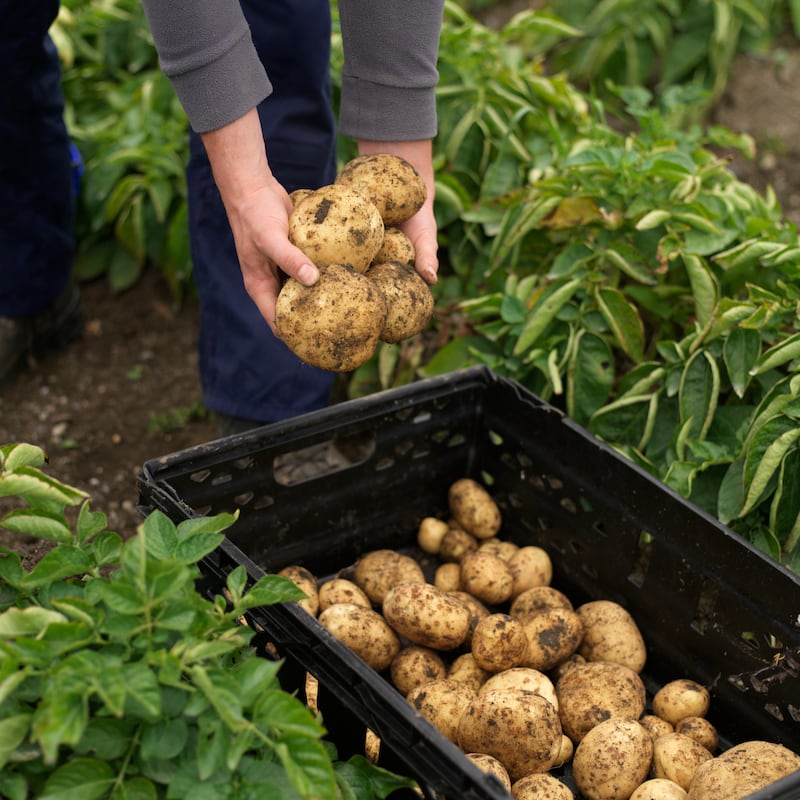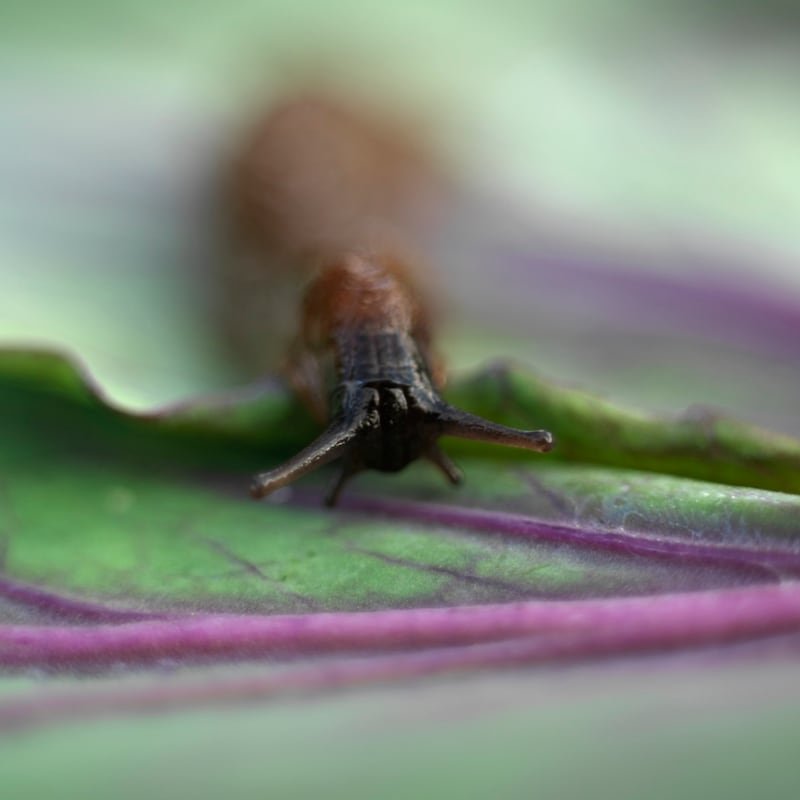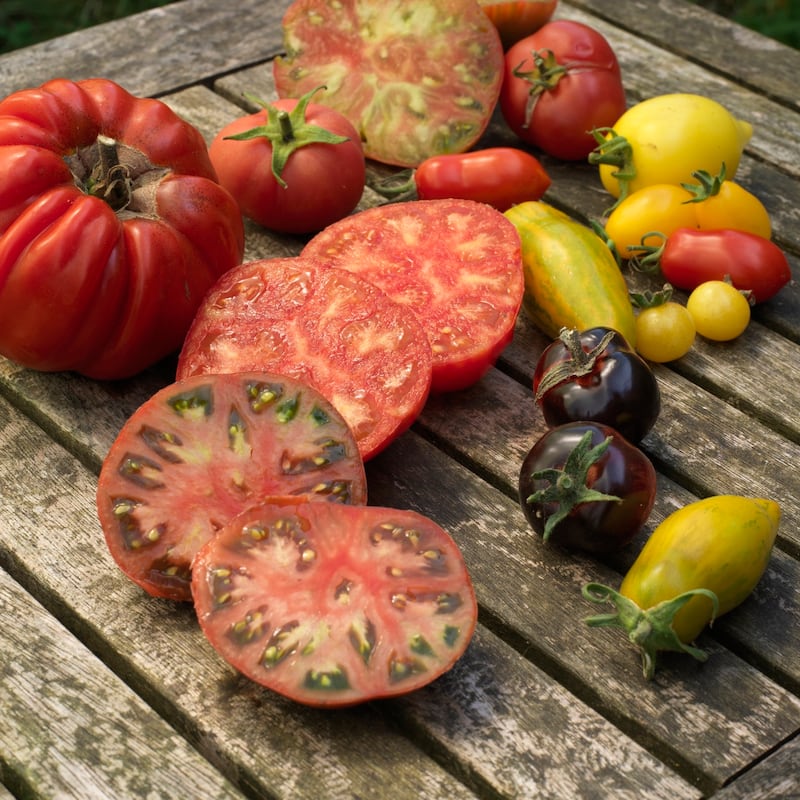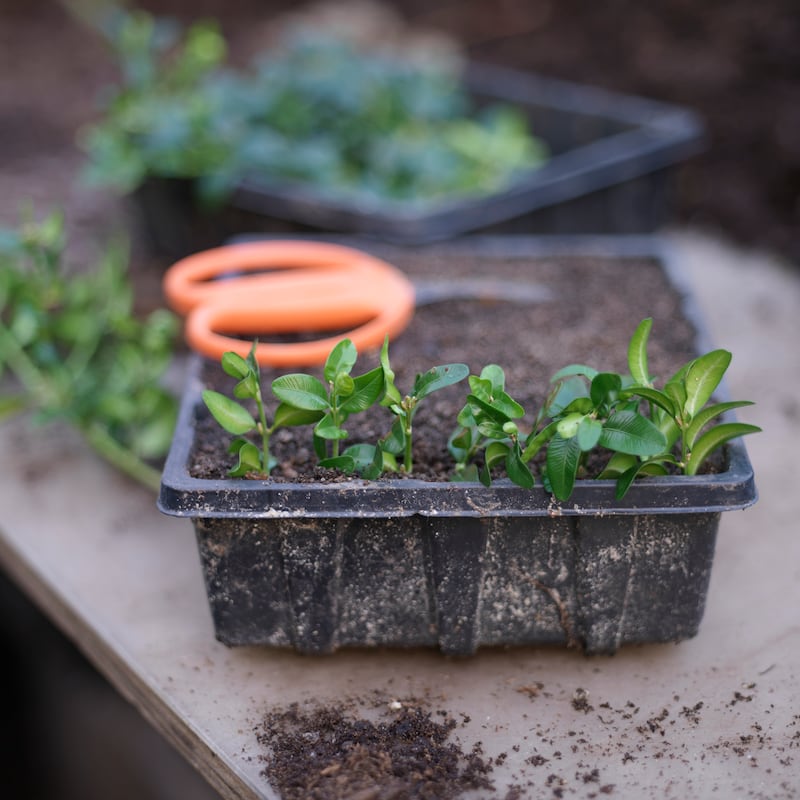After last year’s drought, I promised myself that I’d never, ever give out about our rainy climate again. Not a word. So I’m not going to bemoan the recent torrential downpours or the fact that this is shaping up to be an unusually wet and unsettled August. Yes, it makes for muddy-fingered gardening but plants need water to germinate, grow, flower, fruit and set seed so we gardeners have very good reason to be grateful for the deluges of the last few weeks.
That said, heavy rainfall at this time of year brings its own challenges, especially in the kitchen garden or allotment where it can cause problems with disease, crop damage, soil compaction and abundant weed growth.
An example is potato blight (Phytopthora infestans), the fungal disease that famously flourishes in exactly these sorts of damp, muggy conditions, its spread helped by heavy rainfall washing the fungal spores into the soil to infect any tubers growing in the ground. So keep an extra watchful eye out for the early signs of disease (dark-brown patches/ lesions often surrounded by a pale yellow/ light green "halo", visible on wilting foliage and stems) and pay attention to blight warnings issued by Met Éireann. When/if blight does hit, quickly cut the stems back to ground level and then collect and bag them.

Other moisture-loving vegetable crops are relishing the heavy rain of recent weeks including beetroot, celeriac, celery, cabbage, kale, broccoli, peas and carrots. But so are weeds, which are germinating with alarming speed. While many of these play an important wildlife-friendly role in the wilder parts of any garden, their abundant growth in vegetable beds robs crops of vital plant nutrients and fosters the kinds of conditions that can quickly lead to problems with pests and disease. So it’s really important to keep on top of them before they get completely out of hand. Where you can, try to choose a dry day (fingers crossed) to hoe them down but in tighter corners you’ll need to hand-weed. If you need to walk on wet soil to do so, make sure to protect it first by spreading some wooden boards/planks across the ground to spread your weight and thus minimise the risk of soil compaction.
Bear in mind in that weeds can often quickly re-root in damp soil, so when/if rain is forecast, it’s best to collect them and throw them on the compost heap, bagging any that have already formed ripe seed unless you’re certain that your heap is hot enough to kill them.
Slugs are also relishing the wet, muggy conditions of late as well as the lush cover provided by dense weed growth. While it’s really important to take careful precautions against them (especially when it comes to young transplants and freshly-germinated vegetable seedlings), try to avoid using conventional metaldehyde-based slug pellets, which are toxic to many form of wildlife, pets and soil health.
I find that by far the most effective organic approach is to collect and kill any that I discover lurking near vulnerable plants, using a secateurs to quickly cut them in half and leaving them for the birds to eat. Other traditional, less gory, organic methods of control including beer traps, nematodes (Nemaslug, available to order from good garden centres and online from mrmiddleton.ie) and organically approved slug pellets containing the active ingredient ferric phosphate/ferramol (but use the latter sparingly as they can also have an adverse effect on soil health) as well as physical barriers such as homemade plastic bottle cloches and copper tape.

Remember, also, that some species of slugs (for example, the keeled slug) mainly live and feed underground, the damage they cause to root crops such as potatoes only visible upon harvesting. So if you do spot any obvious signs of slug damage to tubers (typically small entry holes leading to large cavities in the heart of the potato), it’s important to harvest the crop as soon as it’s ready rather than leaving it in the ground until later in the season.
The challenges of the recent rainy weather aside, one of the wonderful benefits of this unusually damp August is that it has created optimum soil conditions for seeds (not just those of weeds) to germinate. Try to take full advantage of this by sowing a nature-friendly green manure “cover” crop into any recently cleared vegetable beds to help boost soil fertility, bolster soil health and add organic matter as well as to minimise opportunistic weed growth.
Examples of green manures suitable for sowing over the coming weeks include field beans, winter vetches/tares, forage rye, crimson clover, buckwheat, and phacelia, some of which are also available as special seed mixes (online suppliers include quickcrop.ie, fruithillfarm.com and mrmiddleton.com).
Those same great soil conditions will also help hugely when it comes to the successful germination and steady growth of many other crops suitable for sowing in August, examples of which include varieties of winter lettuce, rocket, mizuna, mustards Red Frills and Green Frills, pak choi, claytonia, corn salad, annual spinach, beetroot, Swiss chard, certain varieties of cabbage including Greyhound, and any Early Nantes types of carrot. Frustratingly, sourcing seed from garden centres can be a challenge at this time of year but reliable, but recommended Irish online suppliers of organic vegetable seed include brownenvelopeseeds.com, irishseedsavers.ie and greenvegetableseeds.com
Sow these soon and your kitchen garden should be well stocked with delicious homegrown vegetables in the months to come, proving that every cloud– yes, even those great, dark, Irish rainclouds – has a silver lining.

This Week in the Garden…
August is a great time of the year to take semi-ripe cuttings of many types of climbers, perennials, herbs, shrubs and trees. Always use a clean, sharp secateurs or snippers to cut the selected material (ideally in the morning) and choose young healthy growth from a vigorous parent plant, immediately placing it into a freezer bag to which you've already added a few drops of water.
Semi-hardwood cuttings should typically be about 10-15cm long, firm at the base but a little soft at the tips and cut just below a leaf node. Gently strip away their lower leaves, nip out their soft tips and place them up to their waists in a pot filled with a good-quality, free-draining seed-and-cuttings compost. Then gently water the pot before covering the cuttings with an upturned 3L freezer bag to create a plastic tent, seal it with an elastic band and place it somewhere out of direct sunshine, ideally on a heated propagator. You should see obvious signs of new growth within 1-2 months, at which point the rooted cuttings can be potted on and hardened off.
Strawberry plants often produce baby plants or "plantlets" at this time of year, which appear on creeping, rooting stems known as "runners. Once they've established proper roots, these baby plants can be easily removed from the parent plant and then potted on or planted elsewhere, giving you lots of new strawberry plants for your garden or allotment. To encourage a strawberry plant's runners to root, you can use a simple propagation technique known as layering. Just spread them out along the soil surrounding the parent plant, then gently peg them down using a small length of u-shaped string wire and keep them well-watered.
Visit this…The news that owners Gert and Elizabeth Stam have decided to close their much-loved Caherlhurley Nursery in Bodyke, east Clare due to ill health is one that's saddened many Irish gardeners. Before they close the gates for the last time next month, the couple are offering people the chance to buy their organically grown plants at a generously discounted rate. Along with the nursery's wide range of unusual plants, the Stams are also selling off their larger mother stock plants as well as many new varieties not listed in their extensive catalogue. This is a wonderful opportunity for gardeners to stock up on a fantastic range of certified-organic plants chosen for their suitability for Irish growing conditions. Caherhurley Nursery remains open until mid-September (Monday-Thursday, 9am-5pm). For further details, see CaherhurleyNursery on Facebook.
Try this…Dealing with a sudden glut of fruit and/or vegetable is one of the challenges of the kitchen garden/allotment at this time of year. Along with home-freezing, another excellent way to preserve/conserve any homegrown fruit, herbs and vegetables for use at a later date in stews, soups, sauces, pies, cakes is by using an electric dehydrator to dry them. Some examples of the many kinds of homegrown produce suitable for drying in this way include apples, plums, grapes, berries, figs, carrots, cabbage, tomatoes, cucumbers, spinach, courgettes and onions. Stockists of dehydrators include Cork-based Fruithill Farm (€135, fruithillfarm.com)

Dates For Your Diary…. From today, Saturday, August 17th-Saturday, September 1st, National Botanic Gardens, Glasnevin, Dublin 9, Totally Terrific Tomato Festival with a huge range of heritage and/or unusual varieties on display in the garden's Teak House, plus expert talks by the garden's director Dr Matthew Jebb and the Dublin gardener, tomatophile and founder of the festival, Nicky Kyle, see botanicgarden.ie for details;
Saturday, August 24th (2.30-4.30pm), Howth & Sutton Horticultural Society Autumn Show and Plant Sale, St Nessans Community School, Baldoyle, Dublin 13, see hshs.ie for details;
Saturday, September 7th, Kells Bay Gardens, Ferns, Co Kerry, with an impressive line-up of expert speakers including planthunter Tom Hart of the UK's World Garden Plants, plantsman, author and designer Jimi Blake of Hunting Brook, horticulturist and planthunter Thomas Hart-Dyke of Lullingstone Castle and Adam Whitbourn, head gardener of Blarney Castle. The Symposium supper also takes place in Kells Bay Garden's conservatory on Friday evening ( September 6th, €30). Tickets for both are selling out very quickly, so pre-booking is essential. Call/email Billy Kelly at 0877776666 or billy@kellsgardens.ie, tickets for main event €75.






















